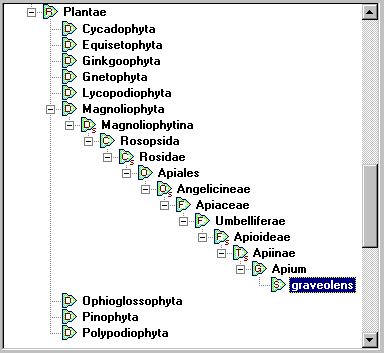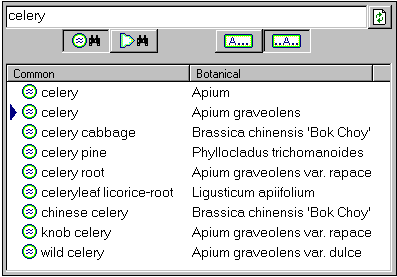|
Data that you collect is recorded in specimen records where each record captures
the details of a single species. (The sample database provides a ready-made
collection of many of the most important and useful plants grown for food,
medicine and beauty.)
Each record in the
specimen list is identified by the all important botanical name. This
internationally recognized key to a species is supplemented by the vernacular
names that we frequently like to use. Vernacular names are internally kept
separate from specimen records. This separation allows the list of
vernacular names to be easily searched for corresponding botanical names. It
also handles two commonly occurring problems: botanical names which are
referred to by more than one vernacular name, and similar sounding
vernacular names which are applied to different species.
.......................................
|

|
The history of every botanical name can be tracked through a third list, the
taxonomic checklist, which records the name of the person who first identified
the species and the publication in which its description was made. This
taxonomic checklist is organized hierarchically by family, genus, species, and
so forth using twenty-three ranks spanning from kingdom down to subspecies and
including the horticultural rank of variety at the bottom. These three lists, the specimen list, the vernacular name list, and the
taxonomic checklist, are tightly linked within The Compleat Botanica�s forms
so that it�s easy to find and access related information throughout. Of the
three, the specimen list is by far the most important to you the user. This
list is where all of the details of your area of interest will be recorded.
|
 The Taxonomic Checklist
The Taxonomic Checklist

|
The taxonomic checklist shows the hierarchical placement within the plant
kingdom of each species proceeding downward from division, to class, order,
family, tribe, genus, and finally species. This snapshot shows the
placement of Apium graveolens under the family Umbelliferae, the
order of Apiales, the class of Rosopsida, and the division of
Magnoliophyta.
.......................................
|
 The Taxonomic Checklist
The Taxonomic Checklist
leads to the Specimen List
|
|
The specimen list is where you record details for individual plants in your
collection.
Here the specimen record for Apium graveolens,
commonly known as celery or smallage, is shown using the
Vegetables, herbs & spices filter.
.......................................
|
 The Specimen List
The Specimen List

|
The Vernacular Name List
leads to the Specimen List

|
|
 The Vernacular Name List
The Vernacular Name List

|
The list of vernacular names shows other plants commonly called celery. Here
the selected entry refers directly to the specimen shown above.
.......................................
|
|